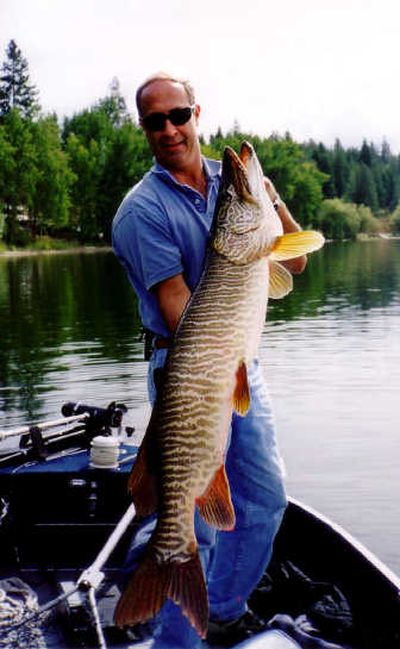Tiger muskies are living large

Washington led the country in tiger muskies reported caught and released in 2007 according to Muskies Inc., an international, nonprofit group that tracks the catching-and-releasing of the big trophy fish.
Last year, 11 of the top 25 fish came from Washington waters, said Scott Hughes of the group’s Washington chapter.
Idaho still leads the Northwest for producing the biggest specimens, with a 2001 state record of 38 pounds 7 ounces – 7 pounds larger than Washington’s record.
However, since the excitement of a new Idaho state record on an almost yearly basis has subsided in the past seven years, the fishery isn’t quite so high-profile.
The world record, incidentally, is a 54-incher weighing 51 pounds.
But Washington anglers, spurred by Muskies, Inc., intend to grow more of those bigger fish with a new 50-inch minimum length for tiger muskies enacted this year. Shorter muskies must be released. The previous minimum length the fish were required to reach before they were eligible to be harvested was as little as 36 inches. In Idaho, the minimum is 40 inches.
Tiger muskies are a sterile, hybrid cross between muskellunge and northern pike. Since 1998, tiger muskies have been stocked in seven Washington Lakes to provide trophy fishing and help control non-sport fisheries, such suckers, northern pikeminnows, tench, carp, and sunfish.
“These are expensive fish to raise and we’d like to keep them in the lakes longer before they’re eligible for harvest so they can be available longer for a trophy fishery and give them more time to do their job of controlling other fish,” said Marc Divens, Washington Fish and Wildlife Department warmwater biologist in Spokane.
Idaho has been putting the big predators in at least five North Idaho lakes, starting in the early 1990s.
Both states faced a tiger musky crisis a few years ago as a threat was identified for bringing a virus into the Northwest from where the hybrids were being produced in Minnesota.
Washington has developed a decontamination facility at the Meseberg warmwater hatchery in the Columbia Basin, where hybrid eggs from Minnesota must be verified disease free before they can be reared in regular hatchery races. Idaho to date has not secured a reliable source of tiger muskies for the future, officials said.
“We released fish in 2007, but none were available for 2008,” Divens said. “We’re raising fish right now for release in 2009.”
He said the tiger muskies are about 14 inches long when they’re stocked at a rate of about one for every two surface acres of water. That translates into about 200 for Silver and 300 each for Curlew and Newman.
In recent years, the Newman tiger muskies have not been growing as fast or as fat as those in Silver and Curlew, he said.
Divens said the largest fish official weighed and measured out of the Eastern Washington lakes are:
Silver – 17 pounds, 42 inches long,
Newman – 27.5 pounds, 45 inches long,
Curlew – 29.5 pounds, 46 inches long.
“The owners of Tiffany’s Resort on Curlew lake say they’re seeing more and more anglers coming in just to fish for tiger muskies,” Divens said.
“At Curlew, the fish have fulfilled our management goals by reducing the pikeminnow population. They also feed on trout. But with our hatchery fry program and the net-pen project handled by lake residents, we can maintain great trout fishing and still have the tiger muskies.”
About 16,000 anglers devote a significant amount of hours to catching a tiger musky each year in Washington, state data show. And almost every angler relishes the surprise of hooking a big tiger even if it’s an accident.
Bass fishermen who cast along the shores in Silver Lake or Curlew Lakes need to prepare themselves for the heart-stopping probability that a fish as long as their boat is wide may slam their lures.
“Curlew is my bet for producing the first 50-incher in this area,” Divens said.
Divens captured and released a 42-incher at Silver Lake last week during a stomach-sampling study. “It had a 13-inch tench in its stomach,” he said. “That’s what we’re hoping for – that these fish will get big enough to take those 12- to 14-inch tench.”
Info: Scott Hughes (509) 714-8944; www.nwtigermuskies.com.